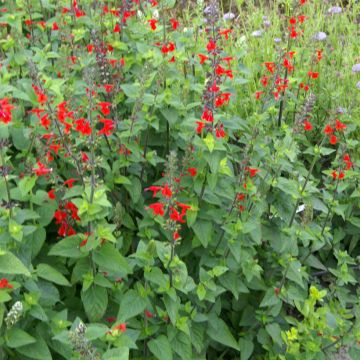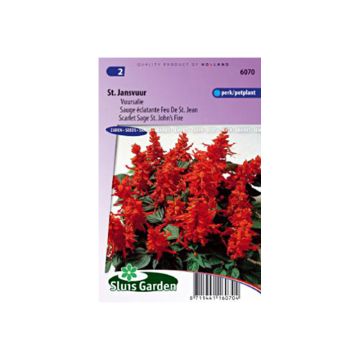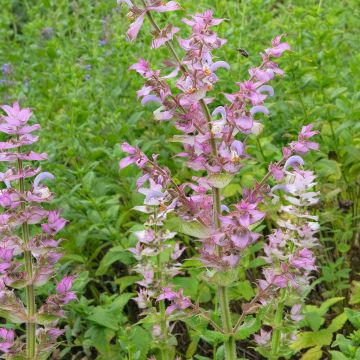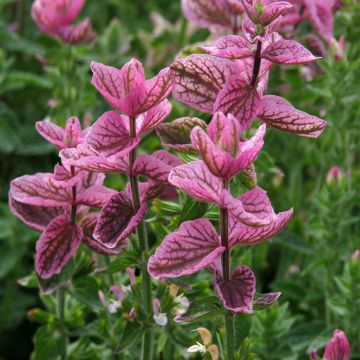

Salvia splendens Lighthouse Purple Seeds - Scarlet Sage
Salvia splendens Lighthouse Purple Seeds - Scarlet Sage
Salvia splendens Lighthouse Purple
Scarlet Sage
Successful as a young plant but superb.
Brigitte M., 27/09/2017
Special offer!
Receive a €20 voucher for any order over €90 (excluding delivery costs, credit notes, and plastic-free options)!
1- Add your favorite plants to your cart.
2- Once you have reached €90, confirm your order (you can even choose the delivery date!).
3- As soon as your order is shipped, you will receive an email containing your voucher code, valid for 3 months (90 days).
Your voucher is unique and can only be used once, for any order with a minimum value of €20, excluding delivery costs.
Can be combined with other current offers, non-divisible and non-refundable.
Why not try an alternative variety in stock?
View all →This plant carries a 6 months recovery warranty
More information
We guarantee the quality of our plants for a full growing cycle, and will replace at our expense any plant that fails to recover under normal climatic and planting conditions.
Would this plant suit my garden?
Set up your Plantfit profile →
Description
Salvia splendens Lighthouse Purple is one of the biggest hybrids of Scarlet Sage available on the horticultural market, but is also a variety that displays the most dazzling purple blooms. Seen from afar, its generous spikes held 60 cm above the ground, are tightly packed with many small flowers of a rich violet-purple hue that displays many nuances in the sunlight. This tall-standing variety becomes the star of sunny beds for the space of a whole season. This perennial plant is grown as an annual in our climates and also performs very well in a large pot in moist, light, well-drained soil.
Salvia splendens is a herbaceous plant of the family Lamiaceae, native to the hot, humid regions of Brazil at an altitude between 2000 and 3000 m above sea level. Sometimes it reaches up to 1.30 m in its native habitat but in our climates, it has much more modest proportions.
The Lighthouse Purple variety is a horticultural hybrid derived from this plant, that has recently won an award at Fleuroselect. It is characterized by its tall, bushy growth habit, its well-branched stems and its particularly developed spikes of flowers. This plant forms bushy clumps that measuring 60 to 80 cm high and 50 cm wide. The quadrangular stems are well-branched and erect. Their brilliant bluish green leaves are oval to lanceolate, toothed and cover the entire length of the stems. The floral spikes measuring 30 cm long and 12 cm in width, rise above the foliage from the beginning of summer to the end of autumn. The 5 cm long tubular flowers are violet-purple and are surrounded by dark purple bracts.
Scarlet sage is the undisputed queen of 'express' beds, which everyone has encountered at least once, on a detour around a neighbouring garden or in the flowerbeds of public gardens. The tall Lighthouse Purple variety with the elegant colour of its blooms, is easier to integrate into summer displays than its little sisters with their flashy red flowers. Used in moderation and planted in small groups that are spread out among other plants with complementary colours (the red in the scrambling rose Red Cascade, the orange of Daylilies, blue Delphinium and the silver in sagebrushes), it adds extra depth to flowerbeds, blooming even when summer perennials go dormant. It also performs very well in a large tub, where it can be used to decorate terraces and balconies.
Flowering
Foliage
Plant habit
Botanical data
Salvia
splendens
Lighthouse Purple
Lamiaceae
Scarlet Sage
Cultivar or hybrid
Other Salvia seeds
View all →Planting and care
Sow in warm conditions, from March to May, at the surface of a good quality special seed starting mix. Make sure the soil is moist but not wet and seal in a polyethylene bag until germination which usually takes 15 days at 18-25 °C. Expose seedlings to light as it is beneficial for germination. Transplant when the seedlings are large enough to be handled, in 8 cm pots and allow them to grow in cooler conditions. Gradually acclimatize them to outdoor conditions for 10-15 days before planting out in the garden, after all risk of frost has passed. Space them 30 cm apart in a sunny spot in ordinary soil that his been raked to a fine tilth.
Scarlet sage loves the sun and requires a deep, well cultivated, fertile soil with reliable moisture. Taller varieties require staking.
Sowing period
Intended location
Planting & care advice
-
, onOrder confirmed
Reply from on Promesse de fleurs
Similar products
Haven't found what you were looking for?
Hardiness is the lowest winter temperature a plant can endure without suffering serious damage or even dying. However, hardiness is affected by location (a sheltered area, such as a patio), protection (winter cover) and soil type (hardiness is improved by well-drained soil).

Photo Sharing Terms & Conditions
In order to encourage gardeners to interact and share their experiences, Promesse de fleurs offers various media enabling content to be uploaded onto its Site - in particular via the ‘Photo sharing’ module.
The User agrees to refrain from:
- Posting any content that is illegal, prejudicial, insulting, racist, inciteful to hatred, revisionist, contrary to public decency, that infringes on privacy or on the privacy rights of third parties, in particular the publicity rights of persons and goods, intellectual property rights, or the right to privacy.
- Submitting content on behalf of a third party;
- Impersonate the identity of a third party and/or publish any personal information about a third party;
In general, the User undertakes to refrain from any unethical behaviour.
All Content (in particular text, comments, files, images, photos, videos, creative works, etc.), which may be subject to property or intellectual property rights, image or other private rights, shall remain the property of the User, subject to the limited rights granted by the terms of the licence granted by Promesse de fleurs as stated below. Users are at liberty to publish or not to publish such Content on the Site, notably via the ‘Photo Sharing’ facility, and accept that this Content shall be made public and freely accessible, notably on the Internet.
Users further acknowledge, undertake to have ,and guarantee that they hold all necessary rights and permissions to publish such material on the Site, in particular with regard to the legislation in force pertaining to any privacy, property, intellectual property, image, or contractual rights, or rights of any other nature. By publishing such Content on the Site, Users acknowledge accepting full liability as publishers of the Content within the meaning of the law, and grant Promesse de fleurs, free of charge, an inclusive, worldwide licence for the said Content for the entire duration of its publication, including all reproduction, representation, up/downloading, displaying, performing, transmission, and storage rights.
Users also grant permission for their name to be linked to the Content and accept that this link may not always be made available.
By engaging in posting material, Users consent to their Content becoming automatically accessible on the Internet, in particular on other sites and/or blogs and/or web pages of the Promesse de fleurs site, including in particular social pages and the Promesse de fleurs catalogue.
Users may secure the removal of entrusted content free of charge by issuing a simple request via our contact form.
The flowering period indicated on our website applies to countries and regions located in USDA zone 8 (France, the United Kingdom, Ireland, the Netherlands, etc.)
It will vary according to where you live:
- In zones 9 to 10 (Italy, Spain, Greece, etc.), flowering will occur about 2 to 4 weeks earlier.
- In zones 6 to 7 (Germany, Poland, Slovenia, and lower mountainous regions), flowering will be delayed by 2 to 3 weeks.
- In zone 5 (Central Europe, Scandinavia), blooming will be delayed by 3 to 5 weeks.
In temperate climates, pruning of spring-flowering shrubs (forsythia, spireas, etc.) should be done just after flowering.
Pruning of summer-flowering shrubs (Indian Lilac, Perovskia, etc.) can be done in winter or spring.
In cold regions as well as with frost-sensitive plants, avoid pruning too early when severe frosts may still occur.
The planting period indicated on our website applies to countries and regions located in USDA zone 8 (France, United Kingdom, Ireland, Netherlands).
It will vary according to where you live:
- In Mediterranean zones (Marseille, Madrid, Milan, etc.), autumn and winter are the best planting periods.
- In continental zones (Strasbourg, Munich, Vienna, etc.), delay planting by 2 to 3 weeks in spring and bring it forward by 2 to 4 weeks in autumn.
- In mountainous regions (the Alps, Pyrenees, Carpathians, etc.), it is best to plant in late spring (May-June) or late summer (August-September).
The harvesting period indicated on our website applies to countries and regions in USDA zone 8 (France, England, Ireland, the Netherlands).
In colder areas (Scandinavia, Poland, Austria...) fruit and vegetable harvests are likely to be delayed by 3-4 weeks.
In warmer areas (Italy, Spain, Greece, etc.), harvesting will probably take place earlier, depending on weather conditions.
The sowing periods indicated on our website apply to countries and regions within USDA Zone 8 (France, UK, Ireland, Netherlands).
In colder areas (Scandinavia, Poland, Austria...), delay any outdoor sowing by 3-4 weeks, or sow under glass.
In warmer climes (Italy, Spain, Greece, etc.), bring outdoor sowing forward by a few weeks.


































































